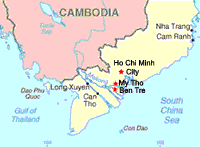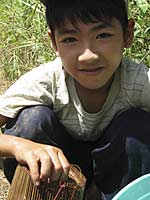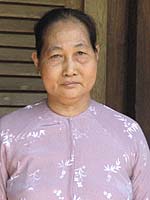




All I have from my reporting at the time are a couple of old newspaper clippings. In one story from My Tho, 40 miles southwest of Saigon, I described how the people "buried their dead, bandaged their wounded, and picked through the rubble of what had been a thriving market city until the Viet Cong came to 'liberate' it." One out of every three or four people had their homes destroyed or damaged.
...the war had "pretty well chewed up" once-beautiful Ben Tre.
In Ben Tre, just a few miles further south, the damage was much worse. "About a thousand civilians caught in the fighting between the Viet Cong and Americans were killed -- twice the number of dead suffered by both the armies combined," I wrote in a UPI piece published by The Guardian in London.
As an American soldier who lived through the fighting told me at the time, the war had "pretty well chewed up" once-beautiful Ben Tre.
I'm now returning to see how Ben Tre and the surrounding province are doing 30 years after the end of the war. I also want my son Matt, who is with me, to see one of the most beautiful parts of Vietnam.

And they seem relatively relaxed despite any number of challenges, from annual floods to population pressures and environmental degradation. Now added to these is the threat of bird flu, which experts fear could turn into a pandemic in places such as the Mekong Delta.
We see chickens roaming everywhere. So I ask a few villagers about the bird flu that has already claimed more than 40 lives in Vietnam. No problem, they say, bird flu is not a problem here in the south.
It's a problem in the "northern region" of Vietnam, they say.
After my departure from Ben Tre Province, the Vietnamese authorities report that bird flu has caused the death of one person in the province, but not in the district we were in.

During our talk at a table inside her home I listen quietly. I feel that there is little I can say.
We also visit the home of a 10-year-old child, Nguyen Thi Hong Giam. A local school official claims that she has birth defects caused by Agent Orange, the defoliant sprayed by American planes to deny cover to Viet Cong guerrillas.
Ms. Giam's arms are shortened and deformed. But to date there has been no research proving whether such deformities are caused by Agent Orange.
Her father and mother both work on construction sites in Saigon. We speak with her aunt, who doesn't discuss her niece's deformities but emphasizes that she's an excellent student.
Ms. Giam, wearing a T-shirt that says "Bushels of Love," shows us her school notebooks. She writes in a neat, careful hand.
Her home appears to be one of the most ramshackle in the village, but her demeanor is serious, dignified.
Then we move on.
Matt begins to check out what lies ahead on Ben Tre Province's dirt and gravel roads.